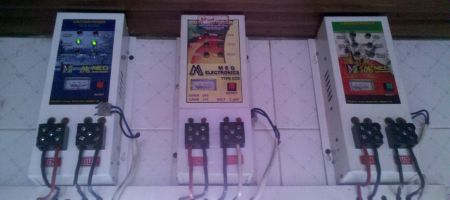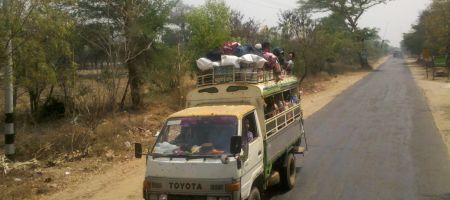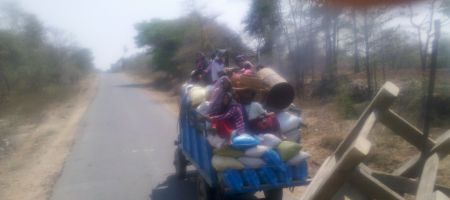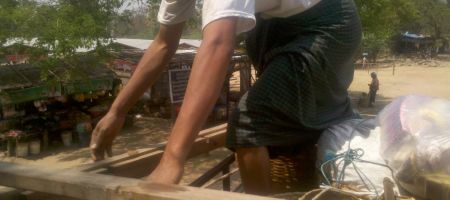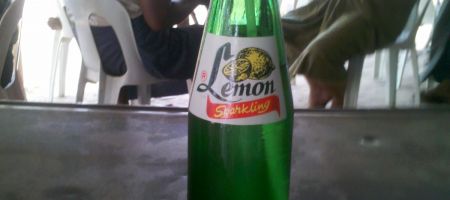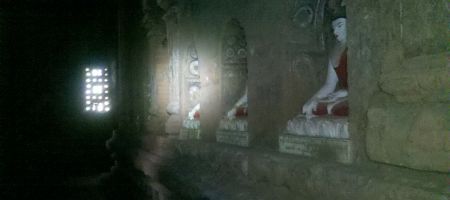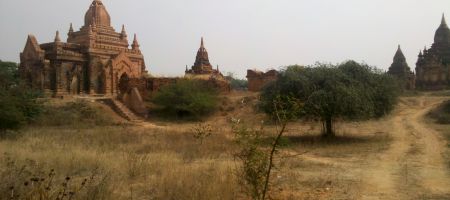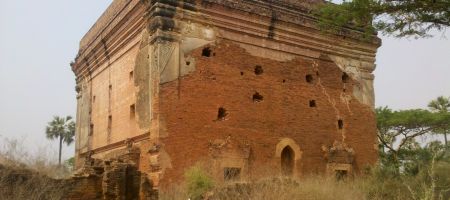M-150
Back in Thailand, at a motortaxi stand:
I wondered about the below plastic box with bottle caps inside. Are they saving for the nuclear apocalypse? I asked about it, the reply was…
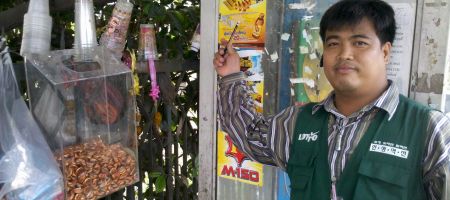
…“Jackpoooot!!!! Em Loy Ha sip!!!! Yeaaaah”. He even posed for a photo :-)
For those who don’t know: M-150 (spoken: “Em Loy Ha Sip”) is the most popular Thai energy drink. In Thailand, the cradle of civili energy drinks (also Red Bull is originally from Thailand) it is the taxi drivers, minivan drivers and truckers that are into that stuff. Really, they drink it all the time.
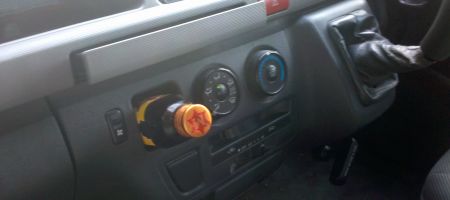
And it seems, some minivans have a built in M-150 holder, just the right shape and size for the rectangular bottle. ;-)

Solar Powered
I’ve never seen so many stores clogged together that sell solar panels than in central Mandalay. The popularity of these is easy to understand. Not only are the environmental conditions quite right for that technology, China is also just next to Myanmar (where they are produced).
And of course, there is the notorious unreliably of the public power network. This is expressed by the “safe boxes” connected in front of every air conditioner there is which monitor the voltage from the socket and, well, do something if the voltage gets to low or high (don’t know what, never happened).
To be more independent of the public power network, many hotels but also shops, restaurants and probably also families have their own generator that supplies power in case of a power cut. Which happen regularly by the way.
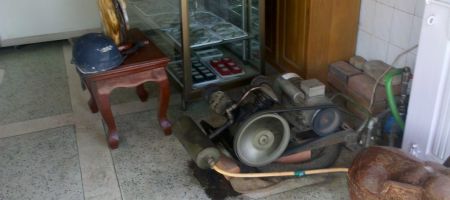
Running generator in a jewelry
Solar panels are normally not installed at a fixed place but just put on some table or sun-lounger in the yard and connected to a car battery. A makeshift charging station. The people can then just connect their batteries with 12V lamps or other systems and be happy. In areas with no electric power at all, like, outside of bigger cities, solar power makes electricity available in the first place.1
The use as a charging station for (portable) batteries is so predominant, that one can buy smaller sized batteries in a format that is easier to carry and sport a carrying handle and all.
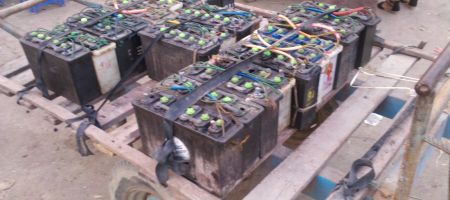
A “power cart”. This cart was used to power a huge sound system which boomed Myanmese pop songs at a flower and vegetable market near the riverside in Mandalay.
Other than Chinese solar panels, there is something else that is sweeping into the Myanmese market. And this is a new, newer than the 2 years since many countries loosened their embargoes on the country. Now since less than half a year ago, so I was told, mobile telephony is available to everyone! So, public telephone boxes tables like these…
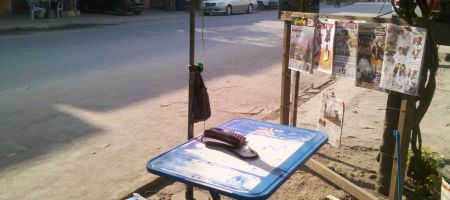
as seen so often on the streets of Mandalay (currently out of order, the operator is on lunch break)
… will die out.
Instead, considering that public mobile telephony is only available to the broad masses since half a year (again, so I was told), Android shops selling Chinese smartphones (Huwai is a quite popular brand here, otherwise fake Samsung and iPhones are also available) are popping out of the ground like mushrooms. The discrepancy between the new shops and the established ones is sometimes striking, like in this photo:
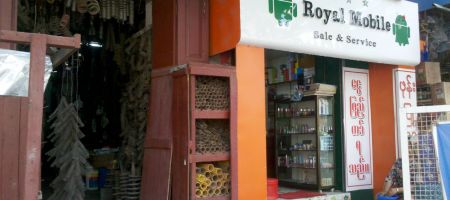
Do you see what the shop on the left is selling?
1 I found the whole idea of being independent of the public power network so alluring, I also wanted to try it out. So I bought a compact 5V solar charger kit for about 21 USD that includes a small 30×25cm panel, a Li-Ion charger with a 5000mAh battery and 3 USB output sockets (and some 5V LED USB lamps). I have yet to put it to proper use, but it’s working so far. :-)

I'm On A Bus
So from Bagan I planned to go to Meiktila with local transportation.
Once out of the tourist infrastructure, I had to experience that suddenly everything takes much longer. Surprisingly it is not that much cheaper as well. I took a pickup from Nyaung U (Bagan) to Kyauk Padaung, made a stop there to visit Mount Popa and changed into a bus to Meiktila afterwards. The whole trip is about 150 km and it took me the whole day (10 hours).
Like transport ships in the old times, it seems, that before a pickup can leave, it has to be loaded so heavily that everything is so stuffed with people and goods that nothing can move even at rough seas. Only then, it sets sail and ponderously leaves the harbour.
During the journey, people got onto and off the pickup and took their goods with them. Mostly farm produce like sacks of rice, big baskets with vegetables but even furniture! In the above photo, the co-driver is fastening a table onto the roof with a rope. Claro, how else would you transport stuff like that other than in public transportation in a country like this if you don’t have a car?1
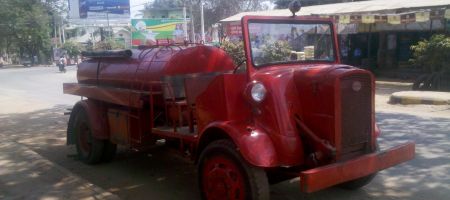
A firetruck at the fire station in Kyauk Padaung. No doubt it is still in use.
While waiting for the bus, I found this brand name very intriguing: “Lemon – Sparkling”. It held its promise.
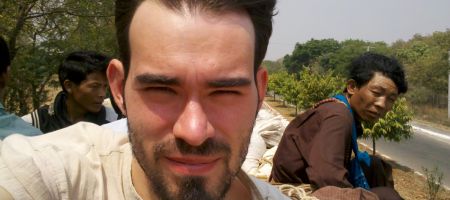
In the same way, the journey was quite exhausting. As you see on the photo, I avoided the crowded inside of the pickup in exchange for a heat stroke on top of it on a cloudless day in the savannah at 35°C.
The bus from Kyauk Padaung2 to Meiktila was also a sight: All the seats except for the first 6 rows or so had been removed to make place for cargo. In my case, the cargo was a few dozen white sacks with gravel, cement or something. Additionally, the departure was delayed because the drivers had to scrape of the lettering from the front and replace it with another. Obviously, the route or the company that owned the bus just changed.
Regarding the “we transport everything” attitude, another thing comes to my mind: In Thailand, I watched a few times how minivan drivers would receive and transport common post parcels along with their normal freight (passengers). I wonder if they are perhaps contracted by local post offices to transport some parcels on fixed routes?
1 Though it is to say, there is not really anything like public transportation, the pickups are more like collective taxis (“Sammeltaxis”).
2 Which I mapped by the way. However, except for the fire station and the bank, I took everything from satellite after the trip. So all roads are on the map now, but the city looks quite empty still. Let’s see how many mappers come by Kyauk Padaung in the following years and survey it. They are working on a good basis now. (Click for animation)
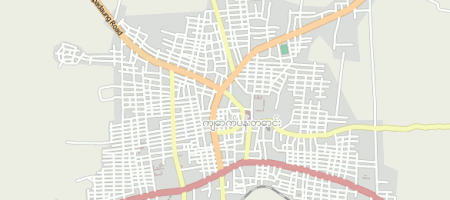

Temples of Bagan
Bagan is an ancient city once the capital of the Kingdom of Pagan, a mighty Burmese empire during the middle ages (849–1297 AD). What remains of the capital now are the over 2000 ruins of temples and pagodas in various states of decay scattered over the otherwise arid savanna landscape, some of which are being restored or even reconstructed. Only the largest ones are frequented by tourist (group tours), all the others just wait to be explored by individual travelers.
Reminded me a bit of the ruins of Hampi which I explored seven years ago in India.
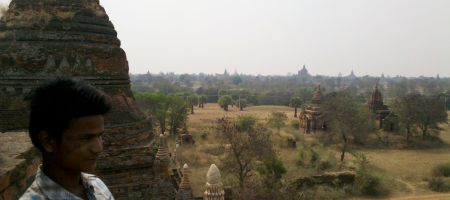
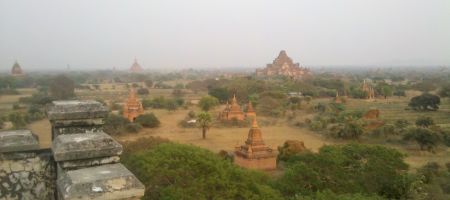
A local showed me a stairway inside a temple which led up onto the roof of it.
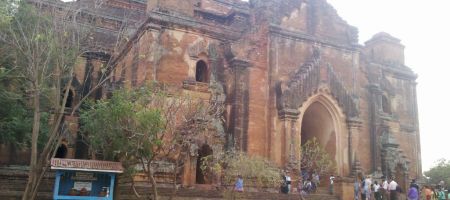
One of the larger, cathedral-size temples. Seen in the background of the previous picture
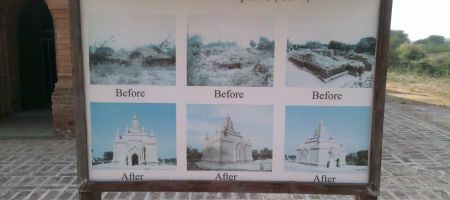
“Restoration” of a temple. Well…, I would use a different word.
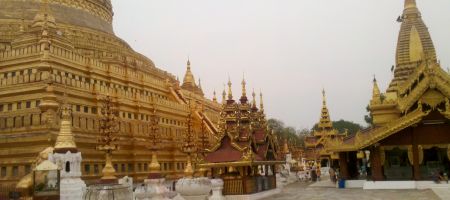
This pagoda, the Shwezigon, has been completely restored and is now frequented by Buddhist pilgrims and monks
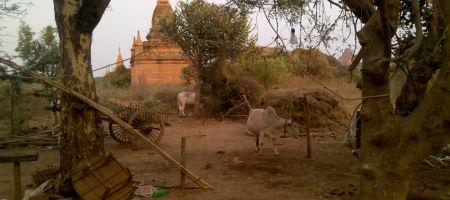
Finally, one picture puzzle: Count the things on the picture which indicate that this photo was made at least in the 20st century! (There is one black object on the photo that indicates this photo was made in the 21st century, but it is too hard to find, or is it?)
Comment [3]

My E-Dirtbike
So, since 2007 it is forbidden in Myanmar for foreigners to drive motorcycles because of the danger of accidents. But nothing against bicycles. And if bicycles, then of course also bicycles with an “auxiliary” electric motor, e-bikes. And since China started flushing its goods into the country, there is a great availability of these. Though, those bikes more resemble small scooters than bicycles, in shape, weight and also function.
There are still pedals, but who used the pedals on his moped (moped = motor + pedals) anyway?
So, guess what, I decided to try out one of those things in Bagan, a vast sandy savanna landscape that is best explored on wheels. I was imagining that this is how Africa must look.
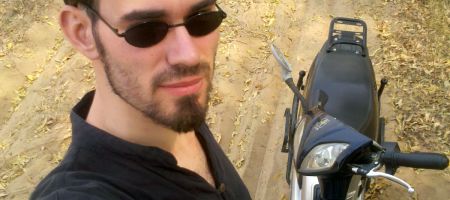
And here is the proud hirer of the said bike. Smile! No,… smile! Oh well, fair enough.
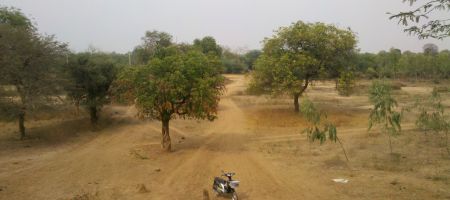
Hot, dry and sandy
My impression: Those things drive like scooters with a very small engine and locked on the highest gear. So, on full throttle and still no acceleration plus already problems at light inclines. But it was funny to ride it on the paved roads.
However, most roads in that area are not paved at all, in fact, all roads that are not the main roads between the towns. All others are sand tracks, some of which felt like sandboxes.
I had to find out that E-bikes, (no power, no suspension, small wheels) are not exactly the right vehicle to drive on these kind of roads. :-P
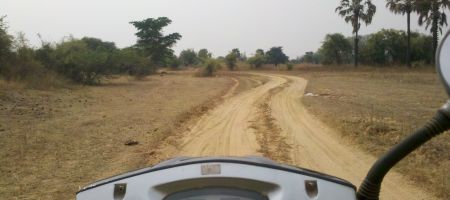
Good shot of the character of the tracks in that area. Driving off-road was actually easier with some of the roads. Also, note the intelligible Chinese driver’s console.
While forcing my bike through all these tracks, I was thinking all the time, “good…, good….! …that my girlfriend is not with me”. She would have been sooo pissed at me for leaving the main roads for these tracks. Just because, because I want to survey unmapped areas for OpenStreetMap!
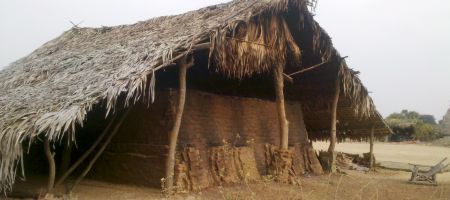
Found brickworks in the middle of nowhere. This could have been in the antiquity, it wouldn’t have looked any different.
And yesh! She would have been right, exploration was my prime motivation to leave the main roads. That, and what will be the topic of the next article. After all, what was I doing there actually in this hot and dry savanna landscape, why did I even come there? You’ll find out.
Comment [1]

I'm On A Boat
So, on the Ayeyarwady, Myanmar’s most important river, there are a number of ferry services going down and up to various cities. I went to Bagan with one.
The wooden boat looked like in a really good shape, though it wouldn’t be Myanmar if everything ran smooth: After an hour or so of chugging down the river, a loud “clang” noise was heard, so I have been told. We anchored at a sandbank and the crew inspected something at the hull. After that, we only ran at half speed with 5 knots, until we arrived 5 hours late.
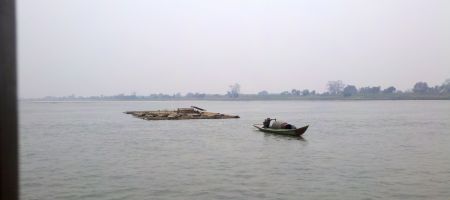
Portable fisherman’s house? Don’t ask me about that. I have no idea either.
In fact, we were so late that it already got dark, which made it very hard for the ship’s crew to navigate us through the river. The Ayeyarwady is a very broad but during dry season a quite shallow river. And on the river, there is no buoyage to mark the shipping channel, at least none that one can see at night. So whenever the depth gauge gave alarm, two crewmen came to the front with long poles and measured the depth each left and right of the bow to feel our way back to the shipping channel, which was often enough not simply the center of the stretch of water but made us go in a slalom.
I have no idea what was wrong with the ship, but I guess it must have been something with the engine because I could see that they put a… fan in front of the engine (to cool it?? What?? :-D). Later, in the dark, they additionally put a crewman with a flashlight in front of it who just sat there and stared at it.
Hmm… did they expect it to catch fire any second now? I better don’t wanna know. Adventure!

Vipassana
So, I have promised you to write a bit about my experiences at the 10 day meditation training at the Dhamma Mandala Vipassana meditation centre near Mandalay, Myanmar.
What is Vipassana meditation?
In a nutshell, it ought to be the mediation technique taught by The Buddha. A path that leads to the liberation in Nirwana (which is not a place!).
The goal is to acknowledge certain truths exclusively through objective observation of your mind and bodily sensations. It is a practice, not an intellectual teaching. So the the teachings are not about that you understand and acknowledge them on an intellectual level but that you experience these truths yourself and in effect gain wisdom, not just knowledge.
In my own words, I would describe the practice as the training to create another, separate, level of conscience that is not influenced by the subconsciousness, bodily sensations and thoughts that wander through the mind. Rather, you are to objectively observe them.
Through the objective observation and the acknowledgement of the impermanent nature of even the tiniest of sensations that you’d normally only feel subconsciously, you train yourself to see things more equanimous. This effectively eliminates your hatred, aversions and desires as you find out for yourself through the practice that those things are merely a product of your subconsciousness, something you have no control over and could be described as a simple bodily function, an automaton, that only acts on the various bodily sensations as input and affections + aversions and actions as output.
By experiencing these sensations consciously, with an equanimous mind instead and not reacting to them, you annul this function. That is the goal. But on the path to it, you continue to diminish it, just like your affections and aversions.
This has advantages on its own, you get more balanced in life, e.g. not get so worked up about what someone said, or did, or didn’t do, about yourself etc. – again, not by acknowledgement but through insight, through practice.
And if you advance further, and you will start to ask yourself – based on your own insights – the question what is the real you, by what are you, your mind defined?
Your subconscious is nothing you can control, just a bodily function like the heartbeat. But this is not you, nor can anything it produces be part of the “core” you, so to say. And, you will find out that you haven’t really been in control of yourself your whole life, that you have been controlled by your subconsciousness, that you thought the things that made you are in fact only a product of it, sensation and reaction, sensation and reaction, sensation and reaction.
The real truth of what you are, what defines you lies deeper within yourself, beyond your affections and aversions, your subconsciousness. And finding this is finding liberation, enlightenment.
So this is the theory. But as I said, and as the teaching explicitly says: It is a practice. So the theory is not important. If the teachings say, “you will experience A and it will lead to B”, then, don’t accept it until you can validate this for yourself through own experience. Don’t believe.
This is one thing I like about the teachings and which distinguishes them from religious texts.
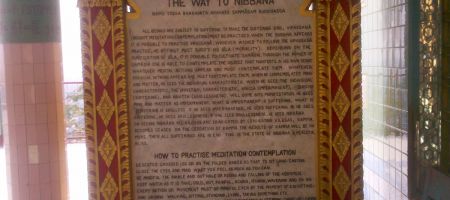
This stone inscription in a Buddhist temple explained the different steps in the practice quite well in English, read it (Samadhi = right concentration). Most of the practice consists of 1. training the right concentration of mind and 2. sharpening your senses to observe bodily sensations.
That “in a nutshell” description got longer than intended. But if you are curious to learn more, perhaps written in a better structured manner, do read about it on their website www.dhamma.org or on the wikipedia (I’m linking to the German article here because I think it is better).
So, a few words about the actual training.
About 50 students attended the course, of which only 7 were foreigners (4 of them Germans) and no hippies. Most students were 40 and up, there were about as many women as men. 3 Buddhist monks participated as students. The students were strictly separated between sexes, we lived in separate areas and had no contact whatsoever with the women other than during group meditation (where they were also strictly separated) to avoid any possible distractions from meditation.
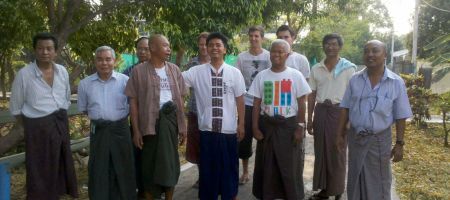
Some of the male students (after the course)
During dry season, when I was there, the surrounding landscape was very dry, there was no grass, the trees withered and dropped their leaves as if it were autumn – at 32°C. Generally of course, that didn’t matter much because we were there to meditate and not admire the landscape. We weren’t allowed to go out of the centre anyway or have any other contact with the outside world or any other students (“noble silence” for the entire duration of the course). The reason for this should be clear – to not add distractions that keep us from meditating.
The accommodation was very basic. It consisted of small bungalows with wooden beds (without mattresses) and without fans. The latter making it unbearable to be inside during daytime, which was kinda okay because we’d meditate in the Dhamma hall during the day. The former is something I was able to get used to during the course as I was so exhausted at the end of the day that I could also have slept on rocks.
Then there was the Dhamma hall (the place for group meditation) in which we spent most of the day sitting cross- or otherwise-legged.
However, as a negative point, as I found out during the first days, there are all sorts of (etiquette) rules for the Dhamma hall – how you may sit, where you may sit, where you may look (I think, not sure!), what you may do, when you may stand up or go out of the room (to stretch the legs, make a pause), when or how to address the teacher etc. Because of this, I always felt a bit uneasy in the hall because the atmosphere there seemed so stiff and I never knew if I got to know now all the rules or if I will put my foot in one’s mouth another time if I do this or that. This has nothing to do with the teachings of Vipassana. It is just that the Myanmese are more traditional and have certain customs how this kind of thing is organized.
So, that is why I preferred to go to the meditation cell complex whenever the teacher gave permission after the group meditation. I couldn’t just meditate anywhere I liked but everyone always went to the hall first and be given instructions by the teacher. This may also be only the case in more traditional / strict centres in Myanmar, I don’t know. (I also didn’t like that: Just like all these rules in the Dhamma hall, it caused my mind to get distracted by negative and rebellious thoughts about the organisation of the whole thing making it harder for me to focus on the actual meditation.)
The meditation cells were basically small solitary cells. Everything in that complex was out of concrete, which was good because it kept the place reasonably cool during the hot afternoon and the monotony of the cell gave my mind very little things to get distracted with. We got assigned a cell we could go to (instead of the Dhamma hall) on the 5th day I think.
I couldn’t help but grin when I first went to the place after we got one cell assigned. It really looked like how one imagines a solitary prison cell. Still, we really welcomed the option to meditate in this room from then on, kind of a privilege, “finally something new” ;-).
As an acquaintance put it, Vipassana is no feel-good-meditation. Yes, there are other meditation techniques that are less hard than Vipassana and which also bring you certain advantages, make you more balanced in daily life etc.; But they do not strive for the highest goal, the liberation, enlightenment. Vipassana on the other hand is hard. And it makes you feel miserable, especially with an untrained mind (on the first course).
I really had to struggle with my mind and motivation, especially in the first days, but really during most of the training.
My mind was rebelling against this attempt to control it, to focus my attention on something so…. boring like the breath for more than a few minutes. It was exhausting. My mind wanted some input, something to busy itself with. It started to wander off, think and dream about this and that, getting angry or sad about so many things from my memory all the time and it took all my dedication to bring it back to the subject, the reason why I was there in the first place, to learn about and practice, give the meditation technique a chance, to bring it back to simply observe, just observe.
The mind is such a monkey. Just try, try to concentrate on anything, like for example your finger, for a few minutes….
It takes much patience to tame the mind to do what you want. Perhaps an early insight one has in meditation, that you don’t have your own mind under control. (I say to myself: “so what do you have under control if not even your own mind, eh?!”).
One reason I struggled so hard with it was because I didn’t come there with the right motivation. I came there most of all because I was curious, intellectually, about this kind of meditation. I did not expect this amount, or better, this intensity of training. I keep using the word training rather than course because it really is training and very little theory. That is what meditation is about after all.
The daily schedule was packed with sitting in meditation from 4:30 AM to 9:00 PM except for about one hour of discourse and the only breaks being the breakfast, lunch and late afternoon break (no food after lunch). We had about six hours sleep a night on said beds.
So, intellectual curiosity is not the right motivation. It takes a willful intent. If you intend to do a course, inform yourself thoroughly about what awaits you, make yourself no illusions, it is hard stuff. But it is the real thing, so it is worth it.
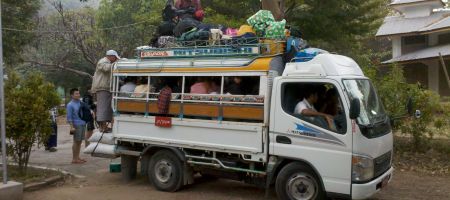
The bus back from the meditation centre
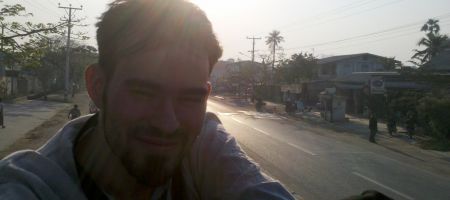
On the bus back to Mandalay: Ahh, exhausted but free again!
P.S: It took me one hell of an effort to write that all down. It is a huge article now, so please at least comment if you read the article with interest.
Comment [3]

Gangnam Style

Gangnaaaaaammmm Styyyylllleeeee11111
I don’t know how things have been moving on back in Europe, but here, I have been haunted, … HAUNTED by that unspeakable hype about the song and the person. You wouldn’t believe how much merchandise is around in South East Asia. These photos are from a toy shop in Mandalay, Myanmar. Most of the products don’t even have the slightest to do with the song.
Number 1 in merchandise however are Angry Birds: pillows, blankets, backpacks, watches, notebooks, books, comics, all sorts of toys, ah, actually, you name it! I cannot imagine any product where I have not seen an Angry Birds themed version of it! No doubt their main source of revenue must be selling those licenses for merchandise, not the game itself.
Of course, given that they get paid at all for it which I personally doubt. The prevailing opinion in South East Asia is that trademarks and copyright is something that happens in other nations. In big, modern malls in centralmost Bangkok, clothes, backpacks etc. with fake brand names are sold everywhere. There are shops where you can buy copies of any software, movie or game for a flat rate of 100 Baht per DVD.1 And when I bought my new notebook in a big IT store, they had the courtesy to pre-install a counterfeit Windows 7 on it. Updates didn’t work, so I replaced it with some legal version I still had a license key lying around. (Thank you, MSDN-AA!)
1 Don’t get the wrong impression, those are not hidden in some dark corners Schlemihl-style but they are shops like any other.

Chinlone
Chinlone is a cooperative ball game that is played round every corner in Myanmar. The goal is simple: The ball may not touch the ground. It’s quite similar to Hacky Sack, the ball however is made out of rattan. The players kick the ball with all sorts of tricks to keep it up in the air.
Now, it seems that every second traveler I meet in Myanmar is German. Why is that? No idea, you tell me.
Anyway, one of that crowd is Clemens from Frankfurt. I got into conversation with him and he told me that he comes to Myanmar every two years to train Chinlone with a local team. He is out to promote the game in Germany. Unfortunately, I missed to go to his training because I was at the mediation centre.
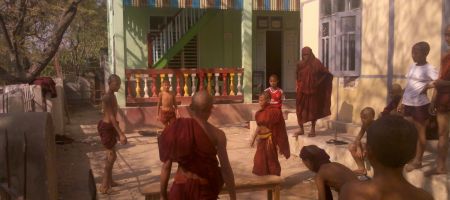
A few children monks playing the chinlone variant with a net in the middle. The rules are a bit like volleyball but of course, they may only touch the ball with their legs and head, not with the arms.
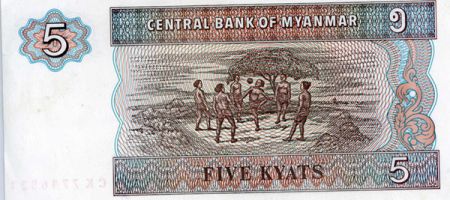
Chinlone is so popular and part of the Myanmese culture that it made it’s way onto the 5 kyat banknote.
German football on the other hand didn’t even make it on the 50 Pfennig coin. Instead, it had a woman planting an oak tree, I never understood this as a boy. The coin-makers of the early BRD seemed to have some obsession with oak trees.
In Myanmar, when you tell people you are from Germany, they enthuse about the country and are like, “Oooh, Germany! Yes, Bundesliga, Bayern Munich! Very good!”. In South East Asia in general, Germany is known first of all for football. Then, also quality technology, but that falls far behind of football.
So, the fat hen which fluttered from the Bundestag onto our Euro coins could easily be replaced by a big round football, after all the shape is already similar. ;-)
By the way, the 5 kyat banknote is worth only 0.00375 Euro now, so it is not really in circulation anymore. The lowest denomination I could get while in Myanmar was a 50 kyat note, and that only because I asked for it. Lena on the other hand still has the full array, a 1 kyat, 5 kyat and a 10 kyat note from when she was in Myanmar over 2 years(?) ago.
Last but not least, here is a short video about some Myanmese playing the cooperative variant at the streetside.

Over 100 articles!
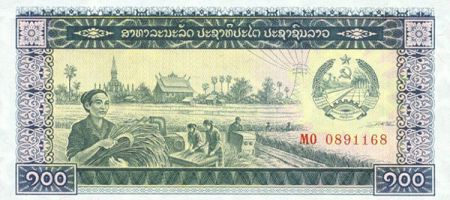
Over 100 articles and more than 6 years I have this blog already! Hooray!
(Above: 100 kip bill from Laos, worth less than 0.01 Euro now)
Comment [2]

